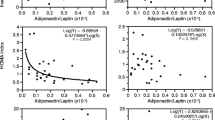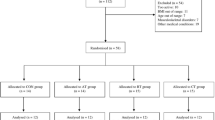Abstract
Purpose
To delineate the direct effect of physical activity on adiponectin metabolism, we investigated the impact of contrasted physical activity changes, independent of body mass changes, on adiponectin plasma concentration and muscle sensitivity in lean and overweight adult males.
Methods
Eleven physically active lean men (70.6 ± 2.1 kg) were subjected to 1-month detraining; 9 sedentary lean men (73.1 ± 3.3 kg); and 11 sedentary overweight men (97.5 ± 3.0 kg) participated in a 2-month aerobic-exercise training program. Diet was controlled to maintain stable energy balance. Body composition, VO2peak, circulating adiponectin, adipose and muscle tissue adiponectin, muscle adiponectin receptors, and APPL1 mRNAs were measured before and after the interventions.
Results
At baseline, plasma high-molecular-weight adiponectin concentration was lower in both active lean (5.44 ± 0.58 µg/mL) and sedentary overweight (5.30 ± 1.06 µg/mL) than in sedentary lean participants (7.44 ± 1.06 µg/mL; both p < 0.05). Training reduced total and high-molecular-weight adiponectin concentrations by, respectively, −32 and −42 % in sedentary lean, and −26 and −35 % in sedentary overweight, while detraining increased them by +25 and +27 % in active lean participants. Total and high-molecular-weight adiponectin changes were inversely correlated with VO2peak changes (respectively, R 2 = 0.45, R 2 = 0.59; both p < 0.001) and positively with changes in fasting plasma insulin (both p < 0.05). Muscle and adipose tissue adiponectin mRNA did not differ between groups and with interventions. Muscle AdipoR2 and APPL1 mRNAs were lower in sedentary groups compared with the active group; and were positively associated with VO2peak and inversely with fasting plasma insulin concentration.
Conclusion
Plasma adiponectin concentration is inversely correlated with aerobic capacity. Future investigations will need to confirm the contribution of changes in muscle adiponectin sensitivity.



Similar content being viewed by others
Abbreviations
- AMPK:
-
AMP-activated protein kinase
- APPL1:
-
Adaptor protein, phosphotyrosine interaction, PH domain and leucine zipper containing 1
- BMI:
-
Body mass index
- ELISA:
-
Enzyme-linked immunosorbent assay
- FFM:
-
Fat-free mass
- FM:
-
Fat mass
- HMW:
-
High molecular weight
- LMW:
-
Low molecular weight
- MMW:
-
Medium molecular weight
- mRNA:
-
Messenger ribonucleic acid
- MOSPA:
-
Monica optional study of physical activity
- SEM:
-
Standard error of the mean
- VO2peak :
-
Maximal oxygen consumption
References
Arita Y, Kihara S, Ouchi N, Takahashi M, Maeda K, Miyagawa J, Hotta K, Shimomura I, Nakamura T, Miyaoka K, Kuriyama H, Nishida M, Yamashita S, Okubo K, Matsubara K, Muraguchi M, Ohmoto Y, Funahashi T, Matsuzawa Y (1999) Paradoxical decrease of an adipose-specific protein, adiponectin, in obesity. Biochem Biophys Res Commun 257(1):79–83. doi:10.1006/bbrc.1999.0255
Auerbach P, Nordby P, Bendtsen LQ, Mehlsen JL, Basnet SK, Vestergaard H, Ploug T, Stallknecht B (2013) Differential effects of endurance training and weight loss on plasma adiponectin multimers and adipose tissue macrophages in younger, moderately overweight men. Am J Physiol Regul Integr Comp Physiol 305(5):R490–R498. doi:10.1152/ajpregu.00575.2012
Beavers KM, Ambrosius WT, Nicklas BJ, Rejeski WJ (2013) Independent and combined effects of physical activity and weight loss on inflammatory biomarkers in overweight and obese older adults. J Am Geriatr Soc 61(7):1089–1094. doi:10.1111/jgs.12321
Bergouignan A, Rudwill F, Simon C, Blanc S (2011) Physical inactivity as the culprit of metabolic inflexibility: evidence from bed-rest studies. J Appl Physiol 111(4):1201–1210. doi:10.1152/japplphysiol.00698.2011
Bergouignan A, Momken I, Lefai E, Antoun E, Schoeller DA, Platat C, Chery I, Zahariev A, Vidal H, Gabert L, Normand S, Freyssenet D, Laville M, Simon C, Blanc S (2013) Activity energy expenditure is a major determinant of dietary fat oxidation and trafficking, but the deleterious effect of detraining is more marked than the beneficial effect of training at current recommendations. Am J Clin Nutr 98(3):648–658. doi:10.3945/ajcn.3112.057075 Epub 052013 Jul 057031
Bouassida A, Chamari K, Zaouali M, Feki Y, Zbidi A, Tabka Z (2010) Review on leptin and adiponectin responses and adaptations to acute and chronic exercise. Br J Sports Med 44(9):620–630. doi:10.1136/bjsm.2008.046151
Cheng KK, Lam KS, Wang B, Xu A (2014) Signaling mechanisms underlying the insulin-sensitizing effects of adiponectin. Best Pract Res Clin Endocrinol Metab 28(1):3–13. doi:10.1016/j.beem.2013.06.006
Christiansen T, Paulsen SK, Bruun JM, Ploug T, Pedersen SB, Richelsen B (2010) Diet-induced weight loss and exercise alone and in combination enhance the expression of adiponectin receptors in adipose tissue and skeletal muscle, but only diet-induced weight loss enhanced circulating adiponectin. J Clin Endocrinol Metab 95(2):911–919. doi:10.1210/jc.2008-2505
de Mello MT, de Piano A, Carnier J, Sanches Pde L, Correa FA, Tock L, Ernandes RM, Tufik S, Damaso AR (2011) Long-term effects of aerobic plus resistance training on the metabolic syndrome and adiponectinemia in obese adolescents. J Clin Hypertens 13(5):343–350. doi:10.1111/j.1751-7176.2010.00388.x
de Piano A, de Mello MT, Sanches Pde L, da Silva PL, Campos RM, Carnier J, Corgosinho F, Foschini D, Masquio DL, Tock L, Oyama LM, do Nascimento CM, Tufik S, Damaso AR (2012) Long-term effects of aerobic plus resistance training on the adipokines and neuropeptides in nonalcoholic fatty liver disease obese adolescents. Eur J Gastroenterol Hepatol 24(11):1313–1324. doi:10.1097/MEG.0b013e32835793ac
Farias JM, Maggi RM, Tromm CB, Silva LA, Luciano TF, Marques SO, Lira FS, de Souza CT, Pinho RA (2012) Exercise training performed simultaneously to a high-fat diet reduces the degree of insulin resistance and improves adipoR1-2/APPL1 protein levels in mice. Lipids Health Dis 11:134. doi:10.1186/1476-511X-11-134
Golbidi S, Laher I (2014) Exercise induced adipokine changes and the metabolic syndrome. J Diabetes Res 2014:726861. doi:10.1155/2014/726861
Goto A, Ohno Y, Ikuta A, Suzuki M, Ohira T, Egawa T, Sugiura T, Yoshioka T, Ohira Y, Goto K (2013) Up-regulation of adiponectin expression in antigravitational soleus muscle in response to unloading followed by reloading, and functional overloading in mice. PLoS One 8(12):e81929. doi:10.1371/journal.pone.0081929
Hara K, Horikoshi M, Yamauchi T, Yago H, Miyazaki O, Ebinuma H, Imai Y, Nagai R, Kadowaki T (2006) Measurement of the high-molecular weight form of adiponectin in plasma is useful for the prediction of insulin resistance and metabolic syndrome. Diabetes Care 29(6):1357–1362
Hayashino Y, Jackson JL, Hirata T, Fukumori N, Nakamura F, Fukuhara S, Tsujii S, Ishii H (2014) Effects of exercise on C-reactive protein, inflammatory cytokine and adipokine in patients with type 2 diabetes: a meta-analysis of randomized controlled trials. Metab Clin Exp 63(3):431–440. doi:10.1016/j.metabol.2013.08.018
Hu E, Liang P, Spiegelman BM (1996) AdipoQ is a novel adipose-specific gene dysregulated in obesity. J Biol Chem 271(18):10697–10703
Ibanez J, Izquierdo M, Martinez-Labari C, Ortega F, Grijalba A, Forga L, Idoate F, Garcia-Unciti M, Fernandez-Real JM, Gorostiaga EM (2010) Resistance training improves cardiovascular risk factors in obese women despite a significative decrease in serum adiponectin levels. Obesity 18(3):535–541. doi:10.1038/oby.2009.277
Kramer M (2005) R2 statistics for mixed models. In: Presented at the 17th annual Kansas State University Conference on applied statistics in agriculture, 24–26 April
Lee S, Park Y, Dellsperger KC, Zhang C (2011) Exercise training improves endothelial function via adiponectin-dependent and independent pathways in type 2 diabetic mice. Am J Physiol Heart Circ Physiol 301(2):H306–H314. doi:10.1152/ajpheart.01306.2010
Mao X, Kikani CK, Riojas RA, Langlais P, Wang L, Ramos FJ, Fang Q, Christ-Roberts CY, Hong JY, Kim RY, Liu F, Dong LQ (2006) APPL1 binds to adiponectin receptors and mediates adiponectin signalling and function. Nat Cell Biol 8(5):516–523. doi:10.1038/ncb1404
Marinho R, Ropelle ER, Cintra DE, De Souza CT, Da Silva AS, Bertoli FC, Colantonio E, D’Almeida V, Pauli JR (2012) Endurance exercise training increases APPL1 expression and improves insulin signaling in the hepatic tissue of diet-induced obese mice, independently of weight loss. J Cell Physiol 227(7):2917–2926. doi:10.1002/jcp.23037
Ohashi K, Shibata R, Murohara T, Ouchi N (2014) Role of anti-inflammatory adipokines in obesity-related diseases. Trends Endocrinol Metab: TEM 25(7):348–355. doi:10.1016/j.tem.2014.03.009
Polak J, Klimcakova E, Moro C, Viguerie N, Berlan M, Hejnova J, Richterova B, Kraus I, Langin D, Stich V (2006) Effect of aerobic training on plasma levels and subcutaneous abdominal adipose tissue gene expression of adiponectin, leptin, interleukin 6, and tumor necrosis factor alpha in obese women. Metab Clin Exp 55(10):1375–1381. doi:10.1016/j.metabol.2006.06.008
Roeykens J, Rogers R, Meeusen R, Magnus L, Borms J, de Meirleir K (1998) Validity and reliability in a Flemish population of the WHO-MONICA Optional Study of Physical Activity Questionnaire. Med Sci Sports Exerc 30(7):1071–1075
Rutkowski JM, Halberg N, Wang QA, Holland WL, Xia JY, Scherer PE (2014) Differential transendothelial transport of adiponectin complexes. Cardiovasc Diabetol 13:47. doi:10.1186/1475-2840-13-47
Schraw T, Wang ZV, Halberg N, Hawkins M, Scherer PE (2008) Plasma adiponectin complexes have distinct biochemical characteristics. Endocrinology 149(5):2270–2282. doi:10.1210/en.2007-1561
Simpson KA, Singh MA (2008) Effects of exercise on adiponectin: a systematic review. Obesity 16(2):241–256. doi:10.1038/oby.2007.53
Van Berendoncks AM, Garnier A, Beckers P, Hoymans VY, Possemiers N, Fortin D, Martinet W, Van Hoof V, Vrints CJ, Ventura-Clapier R, Conraads VM (2010) Functional adiponectin resistance at the level of the skeletal muscle in mild to moderate chronic heart failure. Circ Heart Fail 3(2):185–194. doi:10.1161/CIRCHEARTFAILURE.109.885525
Van Berendoncks AM, Garnier A, Beckers P, Hoymans VY, Possemiers N, Fortin D, Van Hoof V, Dewilde S, Vrints CJ, Ventura-Clapier R, Conraads VM (2011) Exercise training reverses adiponectin resistance in skeletal muscle of patients with chronic heart failure. Heart 97(17):1403–1409. doi:10.1136/hrt.2011.226373
Wu ZJ, Cheng YJ, Gu WJ, Aung LH (2014) Adiponectin is associated with increased mortality in patients with already established cardiovascular disease: a systematic review and meta-analysis. Metab Clin Exp 63(9):1157–1166. doi:10.1016/j.metabol.2014.05.001
Acknowledgments
This study was supported by grants from: Fondation Cœur et Artères; University Hospital of Strasbourg, France; French National Agency for Research (PRNA); Centre National de la Recherche Scientifique (CNRS); and French Ministry of Higher Education and Research through a fellowship (to CG). Authors’ contributions to manuscript: S. B. and C. S. conception and design of research; A. B., S. B., C. S., E. L., and J. D. performed experiments; C. G., C. V., S. B., and C. S. analysed data; C. G. and C. V. drafted manuscript; C. G., C. V., S. B., A. B., E. C. S., and C. S. edited and revised manuscript; and C. G., C. V., J. D., E. C. S., S. B., A. B., E. L., and C. S. approved final version of manuscript.
Author information
Authors and Affiliations
Corresponding author
Ethics declarations
Conflict of interest
The authors declare that they have no conflict of interest.
Additional information
Communicated by Fabio Fischetti.
Rights and permissions
About this article
Cite this article
Gastebois, C., Villars, C., Drai, J. et al. Effects of training and detraining on adiponectin plasma concentration and muscle sensitivity in lean and overweight men. Eur J Appl Physiol 116, 2135–2144 (2016). https://doi.org/10.1007/s00421-016-3466-z
Received:
Accepted:
Published:
Issue Date:
DOI: https://doi.org/10.1007/s00421-016-3466-z




